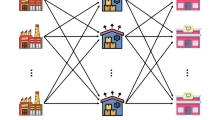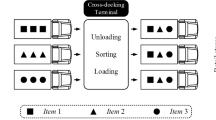Abstract
A single item economic production quantity (EPQ) model is discussed to analyse the behaviour of the inventory level after it’s introduction to the market. It is assumed that demand is time dependent accelerated growth-effect of accelerated growth-steady type. Unlike the conventional EPQ models, which are restricted to general production cycle over the finite or infinite time horizon, we consider the production sale scenario of the very first production cycle for newly introduced perishable product. Shortage is not allowed. Set up cost of an order cycle depends on the total amount of inventory produced. The finite production rate is proportional to demand rate. Optimal production stopping time is determined to maximize total unit profit of the system. A numerical example is presented to illustrate the development of the model. Sensitivity analysis of the model is carried out.
Similar content being viewed by others
References
Deb K (2000) Optimization for engineering design. Prentice-Hall of India, New Delhi, pp 153–171
Donalson WA (1977) Inventory replenishment policy for a linear trend in demand-an analytical solution. Oper Res Q 28: 663–670
Gallego G (1993) Reduced production rates in the economic lot scheduling problem. Int J Prod Res 31(5): 1035–1046
Ghare PM, Schrader GF (1963) An inventory model for deteriorating item for exponentially deteriorating items. J Ind Eng 14: 238–243
Giri BC, Chakrabarty T, Chaudhuri KS (1999) Retailer’s optimal policy for a perishable product with shortages when supplier offers all-unit quantity and freight cost discount. Proc Natl Acad Sci 69A(III): 315–326
Giri BC, Jalan AK, Chadhuri KS (2003) Economic Order Quantity model with Weibull deterioration distribution, shortage and ramp-type demand. Int J Syst Sci 34(4): 237–243
Goyal SK (1988) A heuristic for replenishment of trended inventories considering shortages. J Oper Res Soc 39: 885–887
Goyal SK, Giri BC (2001) Recent trends in modeling of deteriorating inventory. Eur J Oper Res 134: 1–16
Hariga MA, Benkherouf L (1994) Optimal and heuristic inventory models for deteriorating items with exponential time-varying demand. Eur J Oper Res 79: 123–137
Hax AC, Candea D (1984) Production and Inventory Management. Prentice-Hall, Englewood Cliffs
Hill RM (1995) Optimal EOQ models for deteriorating items with time-varying demand. J Oper Res Soc 47: 1228–1246
Khanra S, Chaudhuri KS (2003) A note on an order-level inventory model for a deteriorating item with time-dependent quadratic demand. Comput Oper Res 30: 1901–1916
Khouja M (1995) The economic production lot size model under volume flexibility. Comput Oper Res 22(5): 515–523
Khouja M, Mehrez A (1994) An economic production lot size model with imperfect quality and variable production rate. J Oper Res Soc 45(12): 1405–1417
Manna SK, Chaudhuri KS (2006) An EOQ model with ramp type demand rate, time dependent deterioration rate, unit production cost and shortages. Eur J Oper Res 171: 557–566
Mondal B, Pal AK (1998) Order level inventory system with ramp type demand for deteriorating items. J Interdiscipl Math 1: 49–66
Moon I, Gallego G, Simchi-Levi D (1991) Controllable production rates in a family production context. Int J Prod Res 29: 2459–2470
Nahmias P (1982) Perishable inventory theory: a review. Oper Res 30: 680–708
Panda S, Saha S, Basu M (2007) An EOQ model with generalized ramp-type demand and Weibull distribution deterioration. Asia Pacific J Oper Res 24(1): 93–109
Panda S, Senapati S, Basu M (2008) Optimal replenishment policy for perishable seasonal products in a season with ramp-type time dependent demand. Comput Ind Eng 54(4): 301–314
Raafat E (1991) Survey of literature on continuously deteriorating inventory model. J Oper Res Soc 42: 27–37
Schweitzer PJ, Seidmann A (1991) Optimizing, processing rate for flexible manufacturing systems. Manage Sci 37: 454–466
Silver EA (1990) Deliberately solving down output in a family production context. Int J Prod Res 28(1): 17–27
Silver EA, Peterson R (1985) Decision system for inventory management and production planning, 2nd edn. Wiley, New York
Sule DR (1981) A note on production time variation in determining EMQ under influence of learning and forgetting. IIE Trans 13: 338–343
Wu KS, Ouyang LY (2000) A replenishment policy for deteriorating items with ramp-type demand rate for deteriorating items. Proc Natl Sci council Part A Phys Sci Eng 24(4): 279–286
Author information
Authors and Affiliations
Corresponding author
Rights and permissions
About this article
Cite this article
Panda, S., Saha, S. & Basu, M. Optimal production stopping time for perishable products with ramp-type quadratic demand dependent production and setup cost. Cent Eur J Oper Res 17, 381–396 (2009). https://doi.org/10.1007/s10100-009-0098-y
Published:
Issue Date:
DOI: https://doi.org/10.1007/s10100-009-0098-y




